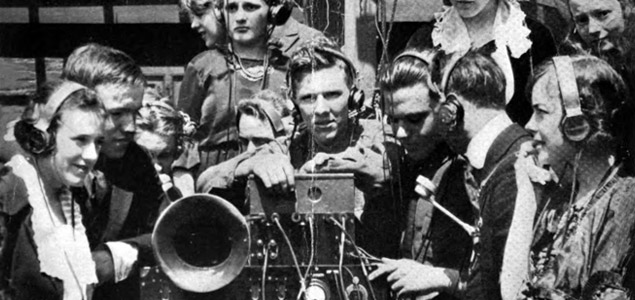
Members of an Atlanta club who danced to music received by wireless ‘phone. Source: Wikimedia Commons.
The Transmedia Narrative Design Workshop, led by Carlos Scolari, will be held on October 27 and 28 as part of the Kosmopolis. Continuous Programme. To coincide with this workshop, we retrieve materials to contextualise this type of storytelling, featuring the Transmedia Manifesto and a selection of tweets from Carlos Scolari’s book Narrativas transmedia. Cuando todos los medios cuentan.
The transmedia manifest
In October 2011, a group of researchers and experts released the Transmedia Manifest, a document that sums up the basic elements of transmedia storytelling in 11 theses:
The art of storytelling has always been subject to change. Through the process of digitalization and the accompanying media convergence, we’re now on the verge of a quantum leap. We are no longer viewers, listeners, readers, users, or players. Today, we are “experiencers”, whose roles and behaviours change based on how we use and approach media. With this reality in mind, we take this opportunity to propose eleven theses on the future of storytelling:
Thesis 1: Claiming reality. Fiction supersedes reality, becoming as immersive as possible.
Thesis 2: Rabbit holes. The story offers multiple entry points to the experiencer, depending on the medium and situation in which it is used.
Thesis 3: Story universe. The experiencer no longer follows one dramatic thread but chooses among several intersecting storylines, which merge into a single story-universe.
Thesis 4: Interactivity. Experiencers communicate with each other and with fictional characters thereby actively participating in the story and influencing its overall arc.
Thesis 5: User-generated content. The story-universe enables the experiencer to contribute creatively at selected points of the story.
Thesis 6 – Transmediality. The story-universe does not limit itself to one single medium but takes advantage of the strengths of every medium to create something new out of their symbiosis.
Thesis 7 – Location based storytelling. The experiencer becomes the vehicle of fiction by visiting real places where parts of the story-universe unfold.
Thesis 8: Lean back, lean forward. The story-universe attracts different types of experiencers by offering a variety of roles for more active and more passive media users.
Thesis 9: Infinitude. The story-universe has the potential to become a breeding ground for a never-ending story through sequels, spin-offs and perpetual re-use of story-elements.
Thesis 10 – Multipayment. The diversification of storytelling enables the freemium-payment-model, which prompts multiple contributions per experiencer.
Thesis 11: Collaborative work. The story-universe is developed in collaboration by a versatile and interdisciplinary team, whose range of skills can meet the demands of experience-based storytelling.
Transmedia storytelling in 11 tweets
Carlos Scolari ends each chapter of his book Narrativas transmedia. Cuando todos los medios cuentan with 5 tweets that sum up the contents of that particular section. We asked the author to select the 11 key tweets that best define transmedia narratives:
- #TransmediaNarratives: stories that unfold in several media + prosumer participation
- In #TransmediaNarratives each medium does what it does best
- #TransmediaNarratives don’t thrive on consumers alone:
no prosumers, no party - #TransmediaNarratives know where stories begin but not where they end
- Textual metastasis: #TransmediaNarratives are organic entities that infect communication platforms and media
- If a producer can’t or won’t produce something, a prosumer will
- The best #TransmediaNarratives are people-centred
- Some stories are crying out to become #transmedia narratives. Others aren’t.
- #TransmediaNarratives are like special effects:
they will never save a bad story. - In #TransmediaNarratives, the boundary between user-generated content and content produced by the cultural industry is porous
- The creation of #TransmediaNarratives can be considered a branch of design:
- transmedia narrative design
We need to master the art of summarising big ideas or long texts in a few lines. In a culture dominated by brief formats (‘snack culture‘) and ‘infoxication‘, being able to present a set of ideas in a series of tweets is not just an added value, it is a fundamental skill for participants of the global hypermedia conversation.


Leave a comment